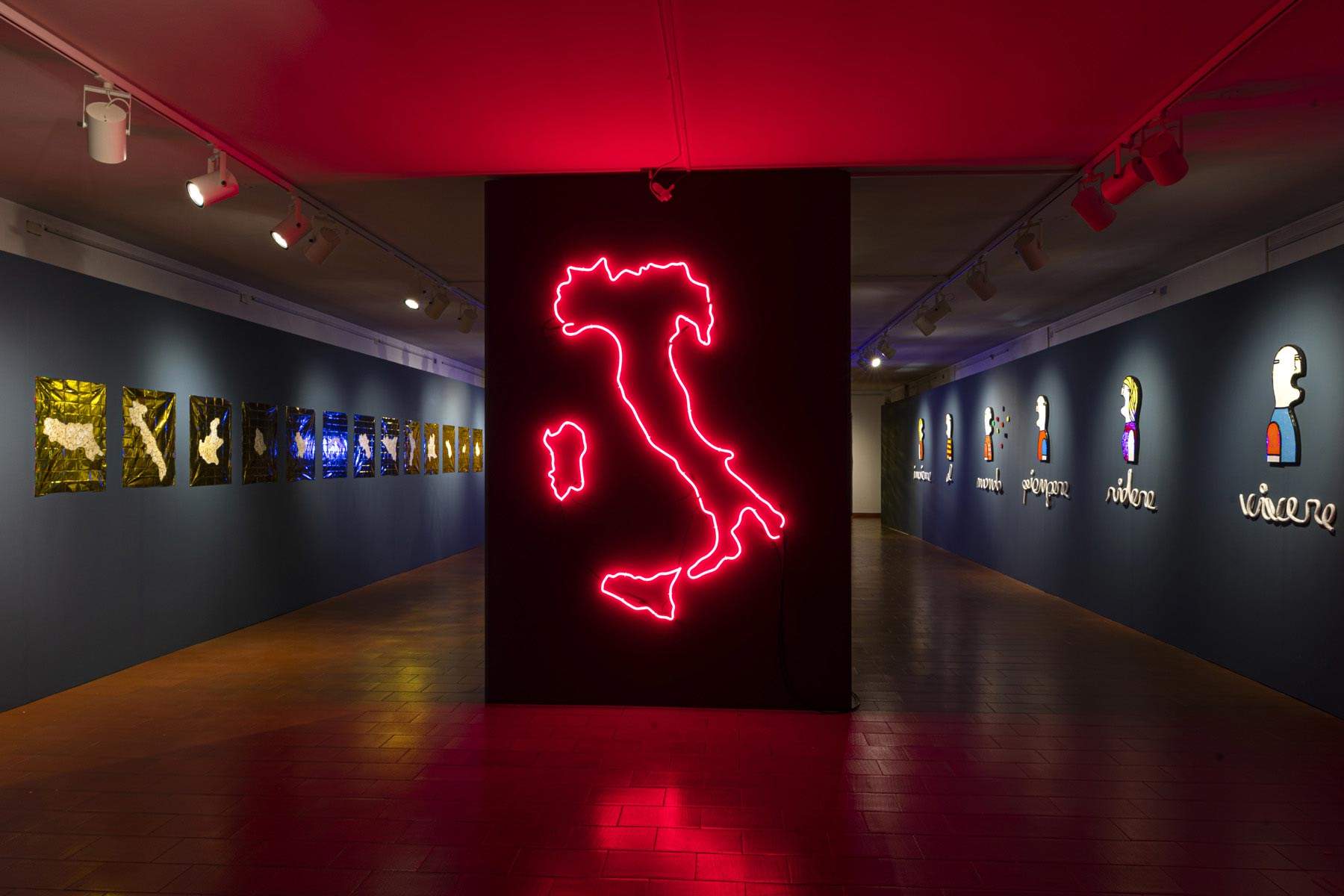From Sept. 20 to Nov. 15, 2020, the Museo Civico delle Cappuccine in Bagnacavallo (Ravenna, Italy) will host Fabrizio Dusi ’s (Sondrio, 1974) solo exhibition titled Together with the World Cry, Laugh and Live, to reflect on the themes that shook consciences in the days of the pandemic, namely distance and solidarity, barriers and missed contacts, loneliness and mutual support. The exhibition is curated by Diego Galizzi and Chiara Gatti.
An artist, painter and ceramist, who has for years ranged between various languages, from sculpture to neon installations, Dusi, who is originally from Valtellina but has lived and worked in Milan for many years, brings to Bagnacavallo an important nucleus of recent works and signs a monumental site-specific installation: it is a large neon light inscription, which will run on the facade of the Town Hall. The intervention turned on last September 19: the idea was to insert into the fabric of the cityan ideal message, which everyone can ... receive under the neoclassical windows and above the loggia overlooking Piazza della Libertà. It is none other than the title of the exhibition, “Together with the world weep, laugh, live,” or words taken from a poem by Rosita Vicari (curiously attributed for a long time to Pablo Neruda), which touch on topical issues such as distancing and at the same time the desire to come together again. In the aftermath of the health emergency, the project thus aims to return art to its original social and pedagogical function, that is, art as a reflection of a shared thought, art as a source of stimuli, questions, universal reflections, art as message and militancy, but also art as omen and attunement to history.
In addition to the public installation that will then remain the heritage of the city, the itinerary at the Museo Civico delle Cappuccine starts with the cycle of glazed ceramic Bla Bla Bla (characters with pop profiles surrounded by bubbles of vacuous words, an allegory of a difficult communication, of a meaningless vociferousness in the chaotic world of today’s relationships) and includes other neon lights, including a large luminous silhouette of Italy, made specifically for the exhibition (and dedicated in this case to the geographies touched by the virus and distanced from each other by a policy of closed borders), as well as a sequence of paintings on isothermal blankets, an allusion to the theme of exiles and migrants, with the Italian regions united by a global fate, albeit in the drama of isolation. The different rooms of the Museum will then encounter a tribute to the figure of St. Michael the Archangel, with a large painting also on isothermal blankets, and a whole wall, covered with the same material, painted on site with the iconography of Adam and Eve under the Tree of Life. Both juxtaposed with words molded in ceramic, reconnected to the theme of the exhibition: crying, in the case of original sin and the pain that resulted from it, as a sign of sharing even in the realization of universal failure, and take care, ideally paired with the figure of St. Michael, defender of the faith, who protects and “takes care” of humans in view of a destiny of redemption. These images find a counterpart in some examples of unpublished ceramics, large vases painted with the same subjects as the tapestries.
“The exhibition,” explains Diego Galizzi, “is a project in tune with our time, and this I believe is a fundamental aspect first because art is first and foremost an expression and interpretation of today, and Fabrizio Dusi offers us a reflection of this that is both fresh and profound, and then because documenting in some way this historical phase I think is also a duty of this museum, which does not ignore the difficulties and constraints of these days, but at the same time takes charge of proposing a reading in perspective of this emergency, which is not only sanitary, suggesting through art paths for its overcoming.”
“Striking is Fabrizio Dusi’s ability to bend a traditional technique such as ceramics (which he masterfully shapes with highly refined solutions) toward a contemporary language, updating styles and themes,” Chiara Gatti adds. “Through the fragility of the earth and, at the same time, the preciousness of gold glazes, also linked to a lesson rooted in the places that now host it, he tells stories of human relationships, closeness, dialogue, contact. Pop imagery marries an ancient craft. While neon lights unravel other stories, fluorescent, electric, in a virtuous short-circuit of visual sensations.”
The exhibition is on view Tuesday and Wednesday from 3 to 6 p.m., Thursday from 10 a.m. to noon and 3 to 6 p.m., Friday, Saturday and Sunday from 10 a.m. to noon and 3 to 7 p.m. Admission is free of charge. For information see the Bagnacavallo Capuchin Museum website.
Pictured is a room from Fabrizio Dusi’s exhibition in Bagnacavallo.
 |
| Art that speaks to us about solidarity during the pandemic: Fabrizio Dusi in Bagnacavallo |
Warning: the translation into English of the original Italian article was created using automatic tools. We undertake to review all articles, but we do not guarantee the total absence of inaccuracies in the translation due to the program. You can find the original by clicking on the ITA button. If you find any mistake,please contact us.